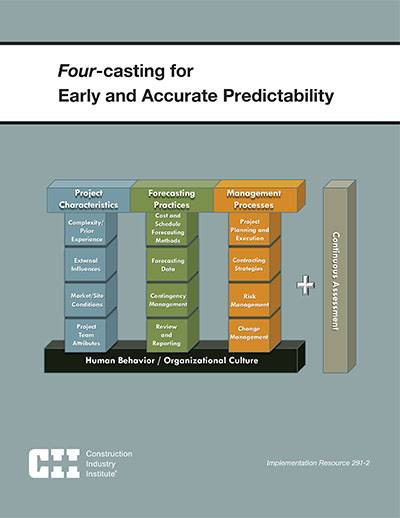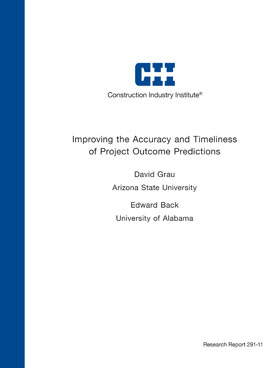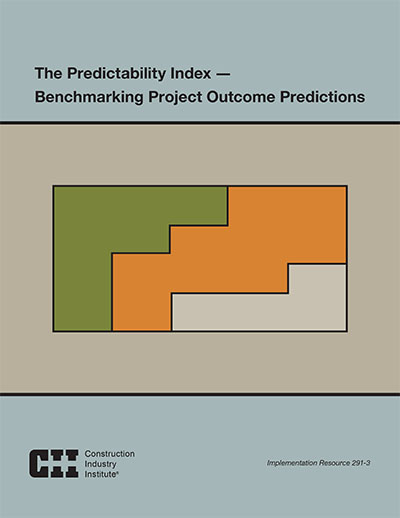
Four-casting for Early and Accurate Predictability
Today’s projects are planned and executed in highly dynamic market environments. Projects are affected, either positively or negatively, by variability in worker productivity, material availability and price fluctuations, unforeseen changes in design and execution, geopolitics, globalization, and many other equally important influences. The reality is that regardless of how well planned a project may be, there are still significant events (both internal and external) that can determine the project’s ultimate success in terms of its anticipated performance criteria. Yet, despite the inherent volatility of real world conditions, project teams are consistently asked to incrementally predict accurate future project outcomes. Moreover, these predictions need to have a high degree of accuracy and reliability in order to have meaningful benefit to the sponsoring organizations. Predictions set expectations of project outcomes, provide the basis for important financial adjustments across a portfolio of projects and for the execution of individual projects, and they drive project team decision making processes. Without the ability accurately predict, project teams are likely to be in a strictly reactive management posture during project execution, and project performance is likely to deviate from projected measures. Clearly, for the benefit of the overall project and of all project participants, these project outcome predictions must be accurate, defensible, and continuously generated, regardless of the project completion stage.
Despite these obvious needs, the reality is that tools, methodologies, and techniques designed to predict reliable and accurate project outcomes are lacking within the industry. Since the need for accurate project outcome predictions is a basic and fundamental need, project team personnel have resorted to a wide variety of approaches to address the issue. Some industry leaders argue that project teams simply lack the ability to make accurate predictions, which leads them to withhold corrective actions until there is stronger data verification or additional indicators to substantiate outcome predictions. The lack of confidence in outcome predictions—or the suspicion of significant inaccuracies—undermines the project team’s ability to adopt proactive execution and corrective strategies. CII chartered Research Team (RT) 291 to address this need, and the team has produced deliverables that enable project teams to become effective predictors.
RT 291 concluded that project outcome predictability is actually influenced by factors across multiple core competencies intrinsic to capital project delivery. The research team concluded that the processes and tools utilized to generate, communicate, and revise a project’s cost and schedule forecast are as diverse as any other techniques used within the profession to address challenges. Importantly however, the research revealed that there were distinct and identifiable differences between effective and ineffective projects with respect to the practices they use to forecast final cost and schedule outcomes. The research team categorized these practices as follows: 1) human behavior and organizational culture; 2) project characteristics; 3) forecasting practices; and 4) management processes. These four categories form the basis of the team’s Four-casting model. Of the four, human behavior and organizational culture was the category statistically shown to have the greatest influence on predictability. In this publication, the four categories of practices are presented serially in Chapters 2 through 5. Each chapter presents the practices with key “takeaway” findings, a list of potential predictability “derailers,” and recommended mitigation actions.
In addition to composing these discussions, the team developed a Four-casting assessment tool to enable project teams to evaluate the effectiveness of their predictability processes as the project progresses, and to identify the categories and practices of influence that require attention. Chapter 6 describes the Four-casting assessment tool. Chapter 7 discusses the team’s findings on classifying change reasons and evaluating the impacts of change. RT 291 also produced Implementation Resource (IR) 291-3,The Predictability Index, to support the predictability practices. This second tool provides a predictability measurement for benchmarking purposes. The remainder of this chapter introduces the model and its predictability practices, and briefly describes the purpose of the assessment tool.
Predictability Practices
The team used its extensive review of the research literature on forecasting and predictability to develop an initial list of factors with an influence on predictability. With this list in hand, the subject matter experts on the team conducted research charrettes during three face-to-face meetings to further identify and group the influencing factors. Research charrettes permit the dynamic, creative generation and communication of a large amount of information in a short amount of time. At these meetings, the team typically worked in small subgroups, which each reported the conclusions of their charrette sessions back to the entire team for further discussion and elicitation. Example of core factors included alignment, transparency, forecasting methods, reporting, information issues, risk, or changes, among others. Based on the identified factors, a total of 72 questions (most of them with a predefined set of answers) were framed for a facilitated survey to collect retrospective project data. Overall, the questions corresponded to practices in the four categories of the model: 1) human behavior and organizational culture; 2) project characteristics; 3) forecasting practices; and 4) management processes.
IR291-2, Four-Casting for Early Predictability
Use for continuous assessment during execution. Provides an assessment of severity or negative impact of 85 elements on predictability. This model addresses each of the four practice categories in separate chapters. Each chapter provides key “take away” findings, a list of potential predictability “de-railers,” and mitigation actions.
- Continuous evaluation of project predictability practices
- Project team member input
- Highlights practices that need attention



